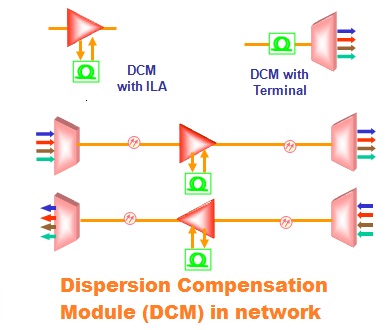Dispersion Compensation Module (DCM) : In optical fiber communication, dispersion compensation module (DCM) (also called dispersion compensation unit, DCU) can be used to compensate for long-span chromatic dispersion of transmission fibers. Typically, such a module provides a certain amount of dispersion (e.g. normal dispersion in a 1.6-μm spectral region), although tunable dispersion modules are also available.
A module can be easily inserted into a fiber-optic link because it has fiber connectors for input and output. The loss of insertion can be compensated with a fiber amplifier, e.g. An erbium-doped fiber amplifier in a 1.5-micron telecom system. We also often see that a dispersion-compensating module is often placed between two fiber amplifiers.
Purpose of Dispersion Compensation Module (DCM)
➤Dispersion is the function of the length of the optical fiber and thus with respect of the length it increases.
➤The purpose of using DCM is that this accumulated dispersion lead to ISI and the loss of the data in the transmission.
➤To overcome this accumulated dispersion and to increase the transmission length we need a module called the Dispersion Compensating Module (DCM).
➤DCM usually consists of optical elements with high negative dispersion coefficient.
Due to dispersion the light pulses spread and tend to overlap with the adjoining pulse period. This leads to interference between adjacent bits and results in high BER. At high bit rates for the same pulse width, the BER (due to dispersion) will become excessive.
DCM (Dispersion Compensation Modules) contain fiber rolls with negative slope of dispersion. Passing fiber through DCM will distort light pulses in a reverse manner thus countering the effects of distortion due to dispersion. DCM’s may be placed at transmitting terminal, receiving terminal, at OADM’s or at ILAs.
The problem of dispersion-compensation can be solved by one of way such as;
1.Dispersion Compensating fiber (DCF)
2.Chirped Fiber Bragg Grating
Any one approaches are more practical and implemented in the field.
Deployment of Dispersion Compensation Module (DCM)
Dispersion Compensation Module (DCM) widley used in DWDM network or we can say that mostly used in LONG HAUL Network. DCM are deployed at various places in the network like-
-After the transmitters
-With in Line amplifiers
-Before post amplifier
-After pre amplifier
The dispersion compensation module can be based on different techniques:
A simple and often used method employs a long piece of fiber, e.g. Wound-spread fiber, wound with a diameter on the spool. 100-200 mm. The fiber used can be adapted to provide dispersion for the compensation of 100 km transmission fiber, introducing an optical loss of only a few decibels.
A more compact approach, also presenting lower insertion losses, is based on a chirped fiber Bragg grating. A large amount of dispersion can be compensated with relatively long fiber grating (possibly tens of centimeters in length). Due to varying the device temperature (with built-in temperature gradients), the dispersion can be tuned. For wavelength division multiplexing systems, virtually imaged phased arrays are used.
Important properties of dispersion compensation modules :
A central aspect is of course the amount of chromatic dispersion provided, which depends on the length of the transmission fiber and the type of transmission fiber to compensate. For example, dispersion-shifted transmission fibers typically require very low dispersion compensation.
The dispersion slope (high-order dispersion) can strongly limit bandwidth, which is particularly important in the case of wavelength division multiplexing. In fact dispersion depending on the type of transmission fiber, different relative dispersion slopes are required. High relative dispersion slopes make fiber design more difficult.
Tunable dispersion is desirable in some cases
Optical insertion losses arise from absorption and scattering in the fiber, but also from splitting and connector losses. Such losses must be low, as they require a high amplifier gain and introduce high noise.
In some cases, optical nonlinearity may be relevant. This is minimal using strongly stretched fibers, where shorter lengths are sufficient.
Compactness can be an important practical aspect. Tight twisting of the compensating fiber may be a solution, but is limited by twist losses.
For very high single-channel data rates, compensating polarization mode dispersion may also be necessary. This is considerably more complex, as it is necessary to monitor the state of the signal for that purpose and correct the time delay accordingly.
Last Word
You must have seen and used DCM or DCU many times in the network, but I have tried to give some specific information about it. If you all feel that I have tried well in this subject, then comment me and share your friends as well. Please tell me how you liked this article Dispersion Compensation Module (DCM).






2 Comments
Nice post, getting FULL Information at one place its really good,, !!! Planet most love music app mp3 juice get here thanks ....
ReplyDeleteNice post, getting FULL Information at one place its really good,, !!! World most Famous app to make life easier without any problems thanks ....
Good work, I completely understand what is DCM in a network
ReplyDelete